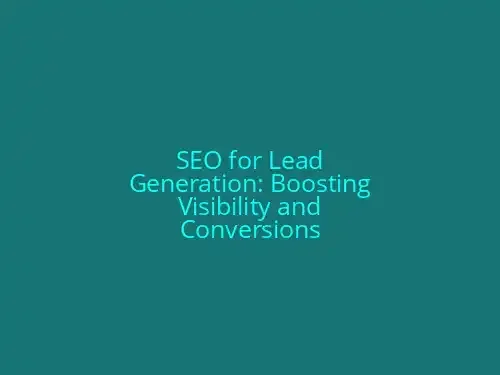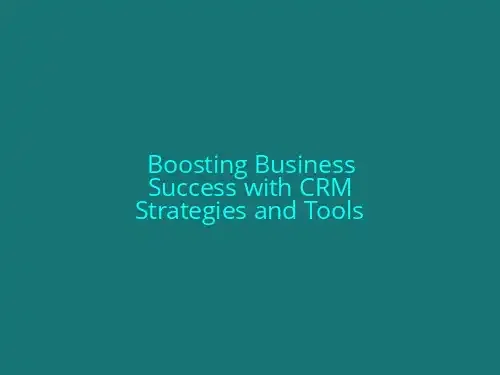
SEO for Lead Generation: Boosting Visibility and Conversions
**The Ultimate Guide to SEO for Lead Generation**\n### 1. Introduction\n**Overview of Lead Generation**\nLead generation is a crucial process for businesses to attract potential customers and convert them into loyal clients. It involves a variety of strategies, including content marketing, paid advertising, and search engine optimization (SEO). SEO is a vital component of lead generation as it enables your website to rank higher on search engines, making it more accessible to your target audience.\n**Why SEO is Crucial for Lead Generation**\nSEO is essential for lead generation because it drives organic traffic to your website, which can then be converted into leads. By optimizing your website for search engines, you can increase visibility for your business and attract more qualified prospects. This is particularly important as SEO results in long-term, cost-effective leads that can sustainably grow your business.\n**The Importance of Optimizing for Search Engines**\nOptimizing your website for search engines is critical for lead generation. It involves ensuring your website is user-friendly, has relevant and valuable content, and is structured to match search engine algorithms. This includes on-page optimizations such as title tags, meta descriptions, headings, and internal linking.\n### Conclusion\nIn this introduction, we have highlighted the importance of SEO for lead generation. By understanding your target audience, conducting keyword research, and optimizing your website for search engines, you can create a solid foundation for attracting and converting leads. The next sections will delve deeper into the specifics of SEO for lead generation, providing actionable strategies and best practices to help you achieve success.### 2. Understanding Your Audience\nUnderstanding your target audience is a crucial step in SEO for lead generation. This involves identifying and creating buyer personas to better comprehend their needs and challenges.\n#### Identifying Target Audience\nTo identify your target audience, you need to analyze your customer base and gather data on their demographics, behaviors, and preferences. Look for patterns and commonalities among your most loyal and profitable customers. This data will help you create detailed buyer personas that represent your ideal customers.\n#### Creating Audience Personas\nCreate detailed buyer personas by considering factors such as:\n- **Demographics**: Age, gender, location, occupation\n- **Behaviors**: Online activities, purchasing habits\n- **Preferences**: Product features, industry trends\n#### Understanding Their Needs and Challenges\nTo create content that resonates with your audience, you must understand their needs and challenges. This involves:\n- **Pain points**: What are their biggest pain points?\n- **Goals**: What are their short-term and long-term goals?\n- **Motivations**: What motivates them to make purchasing decisions?\nUnderstanding your target audience helps you tailor your SEO strategy to effectively attract and engage them. This ensures your content and messaging align with their needs and challenges, increasing the likelihood of generating quality leads.\nBy taking the time to understand your audience, you can optimize your SEO for maximum impact, driving more leads and conversions to your business.**Section 3: Keyword Research**\nKeyword research is a crucial step in the SEO process for lead generation. It helps you identify the right keywords for your business, which in turn drives targeted traffic to your website. Here are the importance, tools, and metrics to consider:\n### Importance of Keyword Research\nKeyword research is vital for lead generation because it allows you to understand what your target audience is searching for and tailor your content accordingly. By optimizing for the right keywords, you can increase your visibility in search engine results pages (SERPs) and attract more qualified leads to your website.\n### Tools for Keyword Research\nSeveral tools are available for keyword research, including:\n- **Ahrefs**: A comprehensive tool that provides detailed insights into keyword difficulty, search volume, and competitor analysis.\n- **SEMrush**: An all-in-one SEO platform that offers keyword research, competitor analysis, and technical SEO audits.\n- **Moz Keyword Explorer**: A free tool that provides keyword research, search volume, and difficulty metrics.\n### Metrics to Consider\nWhen conducting keyword research, consider the following metrics:\n- **Difficulty**: How challenging it is to rank for a specific keyword.\n- **Global Volume**: The average monthly search volume for a keyword globally.\n- **Target Country Volume**: The average monthly search volume for a keyword in your target country.\n- **Traffic Potential**: An estimate of the potential traffic a keyword can drive to your website.\n### Prioritizing Keywords with Business Potential\nTo prioritize keywords with business potential, focus on those with:\n- **High search volume**: Keywords with high search volumes indicate that many people are searching for that term.\n- **Moderate to low difficulty**: Keywords with moderate to low difficulty are more achievable for your website to rank for.\n- **High relevance**: Keywords that are highly relevant to your business, products, or services will attract more qualified leads.\nBy following these guidelines and using the right tools, you can conduct effective keyword research to drive targeted traffic and generate quality leads for your business.### On-Page SEO Optimizations\nOn-page SEO optimizations are crucial for improving the visibility and ranking of your website on search engines. Here are some essential strategies to boost your lead generation efforts:\n#### Optimizing User Experience for PC and Mobile\n- **PC Optimization**: Ensure your website is optimized for desktop use by ensuring clear navigation, readable text, and fast loading times.\n- **Mobile Optimization**: Make your website mobile-friendly by using responsive design and optimizing images to reduce loading times.\n#### Improving SEO Practices\n- **Keyword Placement**: Use relevant keywords strategically in your content, meta tags, and headings.\n- **Meta Tags**: Optimize title tags, meta descriptions, and header tags to accurately describe your content.\n- **Content Quality**: Provide high-quality, engaging, and informative content that addresses the needs of your target audience.\n#### Using Catchy CTAs and Subscription Forms\n- **Catchy CTAs**: Use attention-grabbing calls-to-action (CTAs) to encourage conversions.\n- **Subscription Forms**: Include clear and concise subscription forms that guide visitors through the conversion process.\n#### Live Chatbots for Engagement\n- **Implement Live Chat**: Install live chat tools to engage with visitors and provide instant support, enhancing the user experience.\n#### Avoiding Too Much Text on Landing Pages\n- **Keep it Brief**: Limit text on landing pages to focus visitors on a single action, avoiding overwhelming them with too much information.\nBy implementing these on-page SEO optimizations, you can significantly improve your websites visibility and conversion rates, ultimately driving more leads and sales for your business.
read more →
Boosting Business Success with CRM Strategies and Tools
## 1. What is Customer Relationship Management (CRM)?\n### Definition of CRM\nCustomer Relationship Management (CRM) is a system designed to manage all interactions that a company has with its customers and potential customers. It is a tool that helps businesses build strong relationships with their customers by organizing and analyzing customer data. CRM technology is used by companies across various industries to improve customer satisfaction and drive sales growth.\n### Benefits of CRM in Business\nImplementing a CRM system has numerous benefits for businesses. It helps to enhance customer satisfaction, increase sales, improve efficiency, and streamline processes. Here are some key advantages of using CRM:\n- **Improved Customer Service**: CRM allows businesses to store and manage customer information efficiently, making it easier for customer service teams to resolve issues quickly.\n- **Personalized Marketing**: CRM systems can analyze customer data to help businesses create targeted marketing campaigns that cater to individual customer needs.\n- **Enhanced Sales**: CRM helps sales teams by organizing leads and providing detailed customer information, enabling them to make more informed sales decisions.\n- **Better Data Management**: CRM systems integrate customer data from various sources, providing a single, unified view of each customer.\n- **Increased Efficiency**: By automating routine tasks and providing insights into customer behavior, CRM systems can save time and improve productivity.\nOverall, CRM is a powerful tool that can significantly impact a businesss ability to build strong customer relationships and drive growth.### 2. Key Features of a CRM System\nCustomer Relationship Management (CRM) systems are designed to streamline and enhance various aspects of your business, particularly those related to customer interactions. Here are some key features of a CRM system:\n#### Contact and Account Management\n- **Contact Management**: A CRM helps manage contacts by storing and organizing customer information, such as names, addresses, phone numbers, and email addresses.\n- **Account Management**: It also allows you to manage customer accounts, tracking their interactions, purchases, and service history.\n#### Sales Force Automation\n- **Sales Pipeline Management**: CRM systems help manage sales pipelines by tracking leads, opportunities, and customer interactions to ensure smooth sales processes.\n- **Sales Forecasting**: This feature helps predict future sales performance based on historical data and current trends.\n#### Marketing Automation\n- **Lead Generation and Nurturing**: CRM systems automate lead generation and nurturing by tracking and managing leads through various stages of the sales funnel.\n- **Campaign Management**: It helps manage marketing campaigns by tracking responses and analyzing their effectiveness.\n#### Customer Service and Support\n- **Ticketing System**: CRM systems include ticketing systems that allow customers to submit and track support requests.\n- **Customer Support Automation**: Automation features enable businesses to provide timely and efficient support to customers.\nThese key features of a CRM system can significantly enhance customer relationships and streamline business processes, ultimately driving business growth and success.### 3. CRM Strategies for Business Growth\n#### Understanding Customer Needs and Behavior\nFor a CRM to be effective, it is crucial to understand your customers needs and behaviors. This requires gathering and analyzing data from various touchpoints, such as sales, marketing, and customer service interactions. By doing so, you can identify patterns and preferences that help tailor your interactions and improve customer satisfaction.\n#### Personalizing Customer Interactions\nPersonalization is key to building strong customer relationships. CRM tools enable you to create tailored experiences by leveraging customer data to craft personalized messages, offers, and recommendations. This helps drive engagement, loyalty, and ultimately, business growth.\n#### Streamlining Sales Processes\nStreamlining sales processes is vital in todays fast-paced business environment. CRM systems simplify sales workflows by automating routine tasks, such as lead tracking and follow-ups. This increases productivity and efficiency, allowing sales teams to focus on high-value tasks and close more deals.\n#### Enhancing Customer Retention\nCustomer retention is critical for long-term success. CRM strategies focus on identifying and addressing customer pain points to maintain loyalty. By offering timely support and resolving issues promptly, businesses can significantly reduce churn rates and increase customer lifetime value.\nThese strategies, when implemented effectively, can significantly boost customer satisfaction, sales, and overall business performance.### 4. Choosing the Right CRM Tools and Software\nChoosing the right Customer Relationship Management (CRM) tool and software is crucial for successfully implementing CRM in your business. Here are some points to consider:\n#### Popular CRM Software Options\nThere are numerous CRM software options available in the market. Some popular choices include HubSpot, Salesforce, and Zoho CRM. Each of these tools has its unique features, pricing, and user interface. It is essential to research and compare these tools to determine which one best fits your business needs.\n#### Key Features to Look for in a CRM Tool\nWhen selecting a CRM tool, consider the following key features:\n- **Integration:** Ensure the tool seamlessly integrates with your existing business applications and software.\n- **Customization:** Choose a tool that allows for customization to adapt to your specific business processes.\n- **Scalability:** Select a tool that can scale up or down as your business grows.\n- **Security:** Ensure the tool provides robust security measures to protect your customer data.\n- **User Interface:** Opt for a tool with an intuitive user interface that is easy to use and navigate.\n#### Implementing CRM Software in Your Business\nImplementing CRM software in your business requires careful planning and execution. Here are some steps to follow:\n- **Define Your CRM Goals:** Clearly define your CRM goals and objectives to ensure the implementation aligns with your business needs.\n- **Choose a Deployment Option:** Decide whether you want to deploy your CRM tool on-premise, cloud-based, or hybrid.\n- **Train Your Users:** Provide comprehensive training to your users to ensure they understand the tool and its features.\n- **Integrate with Existing Systems:** Integrate the CRM tool with your existing systems and applications to ensure seamless data flow.\nBy carefully considering these factors, you can choose the right CRM tool and software for your business and successfully implement CRM practices to drive growth and success.
read more →
Effective Brand Management Strategies for a Lasting Online Presence
**I. Introduction**\n**Keyword-rich heading:** Effective Brand Management Strategies for a Lasting Online Presence\n**Meta description:** Learn how to build and maintain a strong brand with our expert tips on brand management. Discover the importance of consistent branding and how to optimize your online presence.\n**Content:** Effective brand management is crucial for establishing a strong online presence and building trust with customers. A well-managed brand helps businesses maintain a consistent image, fosters customer loyalty, and drives conversions. In this article, we will explore the key strategies and tools necessary for effective brand management, ensuring a lasting online presence.\nBy consistently implementing these strategies, businesses can improve their brand recognition, customer engagement, and overall brand value. This introduction sets the stage for the subsequent sections, which will delve deeper into the components and practices of effective brand management.\n---\nThis is the end of Section 1. Please let me know if youd like me to proceed with Section 2 or if you have any further requests.**II. Understanding Brand Management**\nWhat is Brand Management and Why is it Crucial for Businesses?\nBrand management is the strategic process of managing and improving a brands image, reputation, and identity to achieve long-term success. It involves creating a consistent and cohesive brand experience across all platforms, including websites, social media, and marketing materials.\nEffective brand management is crucial for businesses because it helps establish trust with customers, builds loyalty, and increases brand recognition. When done correctly, it can lead to enhanced customer engagement, increased conversions, and ultimately, higher revenue.\nKey benefits of effective brand management include:\n1. **Customer Loyalty**: Consistent branding helps build trust and loyalty among customers, leading to repeat business and positive word-of-mouth.\n2. **Brand Recognition**: A strong brand identity and consistent messaging help customers quickly recognize and remember your brand, increasing brand visibility and credibility.\n3. **Competitive Advantage**: Effective brand management helps differentiate your brand from competitors and establish a unique market position.\n4. **Increased Sales**: Consistent branding and messaging help drive conversions by creating a clear and compelling brand message for customers to respond to.\nBy understanding the importance of brand management and implementing the right strategies, businesses can build a strong and lasting online presence that resonates with their target audience.**Key Components of Brand Management**\n------------------------------------------\n### Essential Elements for a Strong Brand Image\nIn this section, we will discuss the critical components of brand management that help establish a strong brand image. These components are essential for building trust, consistency, and recognition.\n#### 1. **Consistency**\nConsistency is crucial in maintaining a strong brand image. It involves ensuring that all aspects of your brands image, from logos to messaging, are consistent across all platforms. This consistency helps build trust with customers and sets your brand apart from competitors.\n#### 2. **Reputation Management**\nReputation management is vital in maintaining a positive brand reputation. This involves monitoring online reviews, responding to customer feedback, and ensuring that your brands online presence is accurate and reliable. By doing so, you can prevent negative reviews and maintain a positive brand image.\n#### 3. **Identity Development**\nIdentity development is the process of creating a unique brand identity. This includes logos, color schemes, and taglines that define your brands personality and aesthetic. A well-defined brand identity helps create a lasting impression and differentiates your brand from others.\n#### 4. **Brand Messaging**\nBrand messaging is the process of crafting a clear and consistent message that communicates your brands value proposition. This includes developing a unique tone and voice that resonates with your target audience. Clear and consistent messaging helps build trust and establishes your brand as an authority in your industry.\nBy incorporating these essential components into your brand management strategy, you can create a strong brand image that builds trust and recognition with your target audience.**Section 4: Tools and Strategies for Brand Management**\n---------------------------------------------------\n### **Subheading:** Utilizing Technology and Expertise for Effective Brand Management\n**Content:**\nEffective brand management involves using a combination of tools and strategies to maintain a strong brand presence. Here are some key tools and strategies to consider:\n### 1. **Social Media Management**\nSocial media platforms are crucial for brand management. Heres how to leverage them effectively:\n- **Create a consistent brand voice**: Ensure your brands tone and personality shine through in every social media post.\n- **Post regularly**: Maintain a consistent posting schedule to keep your audience engaged.\n- **Engage with customers**: Respond promptly to comments and messages to build trust and foster loyalty.\n### 2. **SEO and Content Creation**\nSEO-optimized content and content marketing play a vital role in brand management. Heres how to use them effectively:\n- **Conduct keyword research**: Identify relevant keywords for your brand and incorporate them into content.\n- **Optimize meta tags**: Use meta tags like title tags and description tags to enhance search engine rankings.\n- **Create high-quality content**: Focus on creating informative, engaging, and high-quality content that resonates with your target audience.\n### 3. **Brand Analytics**\nAnalyzing brand performance helps you make data-driven decisions. Heres how to use analytics effectively:\n- **Track key performance indicators (KPIs)**: Monitor metrics like website traffic, engagement rates, and conversion rates to gauge brand performance.\n- **Use analytics tools**: Utilize tools like Google Analytics to track and analyze brand metrics.\n- **Adjust strategies accordingly**: Based on analytics data, adjust your brand strategies to improve performance.\nBy incorporating these tools and strategies into your brand management, you can enhance your online presence, build trust with your audience, and stay ahead in the competitive digital landscape.
read more →


